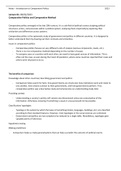Class notes
Lecture notes and book summary - Introduction to Comparative Politics - 2023 - Grade 8.5
- Course
- Institution
- Book
Notes on the lectures from the course (2023) Introduction to Comparative Politics. Includes all lectures and readings
[Show more]



